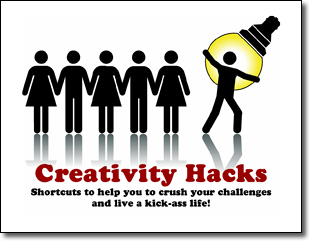What if I told you that you can use the unusual creativity technique favored by some of the most brilliant minds in history to solve your challenges?
Thought experiments are a powerful ideation method used by creative luminaries like Albert Einstein and Leonardo da Vinci to achieve some of their most stunning breakthroughs.
What exactly is a “thought experiment?”
It’s doing “what if” with a challenge you’re facing, looking at it from a totally different perspective in your mind. It’s a mental experiment, if you will. From a creative problem solving perspective, it’s a powerful tool because it whacks you out of your habitual ways of thinking. Therein lies the key to a successful thought experiment: The more unique or unusual the perspective, the better.
Thought experimenter: Albert Einstein
One famous example is a thought experiment where Einstein imagined he was chasing a light wave, observing it while traveling the same speed beside it – the speed of light. He asked himself it would appear to be stationary from his unique perspectives, and imagined what qualities it would have. The insights he gained from this daydream contributed to what became his Special Theory of Relativity. (Read more about it here: http://www.pbs.org/wgbh/nova/physics/theory-behind-equation.html)
Einstein also imagined what it would be like to ride an elevator in free fall; this thought experiment resulted in his conclusion that gravity and acceleration were one and the same force. These “sleight of head” exercises gave him insights he couldn’t have developed any other way.
Thought experimenter: Leonardo da Vinci
Einstein wasn’t the only great thinker to perform such thought experiments. Leonardo da Vinci had an incredibly creative imagination. His approach was to record his vivid imaginings in notebooks, in the form of richly detailed drawings and written explanations. Da Vinci’s writings and sketches helped him transmute his brilliant ideas from his mind into a more tangible form. Once on paper, he could then think about and embellish them further. This was, in a sense, another form of thought experiment. Poring through the pages of this brilliant inventor and painter’s notebooks, it’s clear to see that da Vinci’s focus was on dissecting what he observed in the world around him – a key to creative problem-solving – as well as imagining vehicles, flying machines, weapons and other technologies that were far ahead of their time.
Michael Gelb, author of How to Think Like Leonardo da Vinci: Seven Steps to Genius Every Day, has explored this brilliant thinker’s life and writings in great detail, and has come to this conclusion: “Leonardo’s drawings are reflections of his experiments in seeing. They are attempts to discover the nature of things,” he explained. The lesson for us today? “Approach your experiments in drawing with this delightful anticipation of discovery.”
Thought experimenter: YOU!
So how can you put this thought experiment technique to work in your life? Here are a few suggestions:
Form an imaginary board of directors: Force yourself to think about your current problems or challenges from unfamiliar perspectives. One way to do this is to form a Board of Directors. These people can be anyone, living or dead, famous or obscure. The key is that they have unique creative perspectives. Your goal is to leverage their unique thinking styles to consider your problem or challenge from their viewpoints.
Be the product: Another unique perspective to consider is this: Imagine you are your company’s product, going through its lifecycle – from manufacturing, through shipping, purchase by your customer and so forth. Include as much detail in this imaginary scenario as possible. Where would you be handled roughly? Where would you get “stuck” within the process? Which steps seemed to take too long or were unnecessary?
What’s the bigger frame? Consider the world that surrounds your business. You may think you run a railroad, for example, shipping products to customers. But in reality, if you expand your perspective beyond its habitual horizons, you’re actually in the transportation and logistics business. How does this change in perspective help you to see other products and services you offer to your customers. If you’re in a service business, think of it from the wider frame of providing remarkable customer experiences. How does this change what’s possible for your organization?
Future scenarios: Imagine three future scenarios – one where the market remains much as it is (status quo), one in which a major technological breakthrough revolutionizes it and enables it to grow like never before (positive scenario) and a third in which your organization is blindsided by a negative development, such as the emergence of a new, powerful, well-funded competitor, or onerous new government regulation. Think through in rich detail what would happen and how you would respond or prepare for such outcomes.
Imagine tomorrow’s customer: Picture what your best customer’s business will look like 20-30 years into the future. What opportunities will it be taking advantage of? What will it be challenged by? What changes will they make to stay relevant to their customers? How could you develop new products or services to meet those emerging needs? What can you start doing today to prepare for that likely future?
Analyze weak signals: What emerging developments have you heard about but have dismissed, because they just don’t seem plausible or worth your attention today? Reconsider them. What if that small demographic trend turned out to be really significant 20 years from now? What if that nascent technology got dramatically better and less expensive? What if the raw materials you use to make your product suddenly became scarce, expensive or hard to get in 10 years? What if a small groundswell of negative consumer sentiment toward your company or industry became much more widespread? Play through these thought experiments in detail, and jot notes about any insights you gain from them.
So what thought experiments will you perform?
 Creativity Hacks will inspire you to explore in new places, to make new connections, to dig deeper and discover new insights. It will help you to seek out new knowledge and sources of inspiration - so you can profit from the opportunities all around you. When you're done reading Creativity Hacks, you'll be:
Creativity Hacks will inspire you to explore in new places, to make new connections, to dig deeper and discover new insights. It will help you to seek out new knowledge and sources of inspiration - so you can profit from the opportunities all around you. When you're done reading Creativity Hacks, you'll be:
- Empowered to solve problems and tackle challenges head-on.
- Able to see ideas and opportunities everywhere.
- Able to differentiate yourself and advance your career faster.
Above all, you'll learn that creativity is a skill YOU can cultivate!

